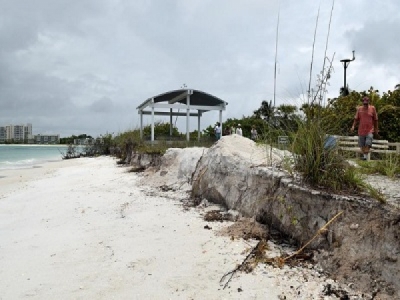
Posted on June 7, 2018
By Nicole Rodriguez, Herald-Tribune
The city is petitioning the state to allocate more money to rebuild chunks of Lido Beach that washed away during Subtropical Storm Alberto, prompting the city manager to declare a state of emergency.
The Sarasota City Commission on Monday passed a resolution asking the state to grant more funding for Lido Beach renourishment projects, while expressing the city’s willingness to match state money to rebuild parts of the shoreline that vanish with each storm that strikes the vulnerable area. The request comes days after City Manager Tom Barwin declared a state of emergency for the severely eroded beach, which lost roughly seven to eight feet of dunes and shoreline from Alberto’s brush with the state.
“The erosion in some parts of the key are as bad as I’ve ever seen it,” City Engineer Alex Davis-Shaw said Monday. “During Alberto, we have videos of waves crashing into a pool of a residential building. So, I think that it is critical that we get this moving as quickly as possible.”
The Florida Department of Environmental Protection already has pledged around $3.3 million for two pending renourishment projects, but the city needs more money to carry out both projects, Davis-Shaw said.
In its short-term project, the city plans to use 150,000 to 200,000 cubic yards of sand from New Pass this fall to renourish Lido Beach. The project is estimated to cost $2 million to $3 million, depending on how much sand is used.
Last month, a judge cleared the way for Sarasota to proceed with plans for its longterm project, ruling the city and the U.S. Army Corps of Engineers should be issued the necessary permits by the DEP to dredge up to 1.3 million cubic yards of sand from Big Pass to rebuild parts of Lido Beach. The ruling dismissed claims by Siesta Key Association that the project would negatively affect navigation and cause harmful erosion to Siesta Key. The association is considering appealing.
Barwin on Monday issued a plea to the association, imploring it to drop a civil lawsuit pending against the project.
“Please respectfully consider ending the litigation to allow us to get on with protecting the shoreline here and joining with us to ensure we do no harm ever and that we work together in the future to monitor our shorelines, our beaches, our inlets, our boating channels and really start to take a long range look at what we’re going to have to deal with over the next few decades,” Barwin said.
State of emergency
City officials hope to start the project once federal money is available.
The initial renourishment would take 950,000 cubic yards of sand from Big Pass and subsequent restoration projects would occur every five years, dredging about 500,000 cubic yards each time. The projected cost is $20 million to $22 million. The federal government will pay 62 percent of the cost; the state will cover 19 percent and the city is responsible for 19 percent, city officials said.
In the meantime, last Wednesday’s state of emergency declaration could qualify the city for regulatory and financial assistance. Since the declaration, DEP has granted the city’s request to allow property owners to double the amount of beach-quality bagged sand placed on the beach to protect private property from 300 cubic yards to 600 cubic yards.
The state of emergency applies to the most threatened portions of Lido Beach. On the southern half of Lido Beach, markers R-37 south to R-44.2 are included. Along the northern portion of Lido Beach, markers R-31 to R-33 are part of the local state of emergency.
The erosion has started financially impacting businesses and caused minimal property damage along the barrier island, Barwin said. Private properties on Lido Beach sustained some damage from Alberto, while the concession stand at Lido Beach Pool and Pavilion has suffered economic losses.
Barwin said he believes other businesses on the island are suffering economically because of the erosion that has prompted patrons to go elsewhere. But it’s still too early to quantify the economic losses, he said.
The city manager said he fears that if the shoreline isn’t rebuilt soon, the next storm could cause push water onto Benjamin Franklin Drive, potentially spurring evacuations and major property damage.
“If we have any significant storm surge, it’s becoming increasingly likely we’ll see the Gulf reach the shoreline and go into residential streets and if that’s the case, then we’d probably have to do an isolated evacuation of the shoreline and other areas of the key,” Barwin told the Herald-Tribune last week. “We’re preparing contingency plans.”
Source: Herald-Tribune





